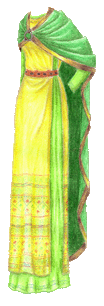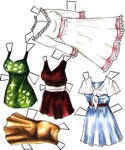 Click for larger version; click for the doll.
Click for larger version; click for the doll.
For the Boutique I did four outfits from A Midsummer Night’s Dream — this is Titania’s dress. I can kind of see where I was going with the sleeve construction, but it looks awfully hard to deal with.
 Click for larger version; click for the doll.
Click for larger version; click for the doll.
For the Boutique I did four outfits from A Midsummer Night’s Dream — this is Titania’s dress. I can kind of see where I was going with the sleeve construction, but it looks awfully hard to deal with.
 Click for larger version; click for the list of dolls.
Click for larger version; click for the list of dolls.
Honestly, I wasn’t quite feeling the whole paperdolling thing today after having three starts to another outfit go bad, so I decided to redraw one of the old Boutique fairy outfits. I’m not really thrilled with it, but it’s better than not posting anything at all…
 Click for larger version; click for the list of dolls.
Click for larger version; click for the list of dolls.
Wikipedia says that “uncritical acceptance of the Annals of Ulster would imply that he [St. Patrick] lived from 373 to 493″ and for the purpose of paperdolling, I can be uncritical. This is my guess at what an upper-class Celtic woman might have worn during the time of St. Patrick. She wears a sleeveless saffron-dyed, heavily embroidered léine, which is a linen tunic, over another light green sleeved léine. At this point, the sleeves, if there were any, were long and straight; the larger sleeves that you might see at a Renaissance fair come later. The green fabric she wears as a cloak is called a brat, and it’s made of wool and edged with gold. She pins the brat with a white bronze penannular brooch, and she wears a woven leather belt.
I cannot say that this is entirely historically accurate; I’ve read about clothes from that time and done my best to make it so, but I’m no expert. I read a lot of great resources about clothing from this time period:
Ceara ni Neill’s Early Period Online
Paul Du Bois’ Book of Kells Images
Clothing of the Ancient Celts
Echna’s Celtic Clothing Page
Crafty Celts
Also, if you’re looking at the dress and thinking “Well, how would someone actually cut that out? Or were hand amputations common in the 5th century?” my advice would be to cut a line between the edge of the sleeve and the cloak and slip her hand through it. This is, of course, if you have already followed my advice (given somewhere…) to cut Sylvia’s hand away from her hip, so that dresses like Margaret Hale’s gown work better.
Brian told me I should have done something for Saint Urho. Maybe next year.
 Click for larger version; click for the doll.
Click for larger version; click for the doll.
I find myself, at the time of this writing, with a terrible headache and no drawings stored up in reserve… so instead of silence I thought I’d post some of my old Boutique dresses and one of the dolls.
When I was in high school and college, I ran a site called “Liana’s Paperdoll Boutique” for which I drew dresses and dolls. It got to be really rather sprawling, and was great fun, although my laziness, perfectionism and inability to really focus on more than one thing with all my heart caught up to me and it slipped away at some point. These are from that old site.
I don’t remember which birthday it was when I got my set of 120 Prismacolors — though I bet my mom could — but in any case, these date somewhere to maybe sophomore or junior year of high school, 1997, 1998. (I’m very bad with dates…) I still remember details about some of them… the blue dress was a request from some paperdoll fan, and the gold dress was my first try at gold, and really my technique hasn’t changed too much. Also, I don’t do the outlines with black ink anymore, and I use the colorless blender instead of white… I don’t think my dolls look a lot better, though, and I post this one with some embarrassment, but hey, it’s history!